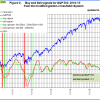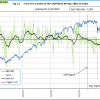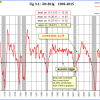Market Signals Summary:
The MAC-US model generated a buy signal early November, thus the model is invested in the markets. The 3-mo Hi-Lo Index of the S&P500 signaled an entry into the markets last week. The MAC-AU remains out of the markets. The recession indicators COMP and iM-BCIg do not signal a recession. The bond market model avoids high beta (long) bonds, the trend of the yield spread is indeterminate. Both the gold and silver model are invested.
Stock-markets:
 The MAC-US model generated a buy-signal early November. The sell-spread is increasing however it remains negative but it is on the verge of crossing to the positive side.
The MAC-US model generated a buy-signal early November. The sell-spread is increasing however it remains negative but it is on the verge of crossing to the positive side.
 The 3-mo Hi-Lo Index of the S&P500 signaled an entry into the markets last week, when the 40-day moving average (MA40) of the index moved from below to above 5.0%.
The 3-mo Hi-Lo Index of the S&P500 signaled an entry into the markets last week, when the 40-day moving average (MA40) of the index moved from below to above 5.0%.
 The MAC-AU model generated a sell signal end of August and thus in cash. The buy-spread is higher than last week’s level. The next buy signal will emerge once the buy spread (green graph) moves above the zero line.
The MAC-AU model generated a sell signal end of August and thus in cash. The buy-spread is higher than last week’s level. The next buy signal will emerge once the buy spread (green graph) moves above the zero line.
This model and its application is described in MAC-Australia: A Moving Average Crossover System for Superannuation Asset Allocations.
Recession:
 Figure 3 shows the COMP is higher than last week’s level, and far away from signaling recession. COMP can be used for stock market exit timing as discussed in this article The Use of Recession Indicators in Stock Market Timing.
Figure 3 shows the COMP is higher than last week’s level, and far away from signaling recession. COMP can be used for stock market exit timing as discussed in this article The Use of Recession Indicators in Stock Market Timing.
 Figure 3.1 shows the recession indicator iM-BCIg also higher than last week’s level. An imminent recession is not signaled .
Figure 3.1 shows the recession indicator iM-BCIg also higher than last week’s level. An imminent recession is not signaled .
Please also refer to the BCI page

Leave a Reply
You must be logged in to post a comment.